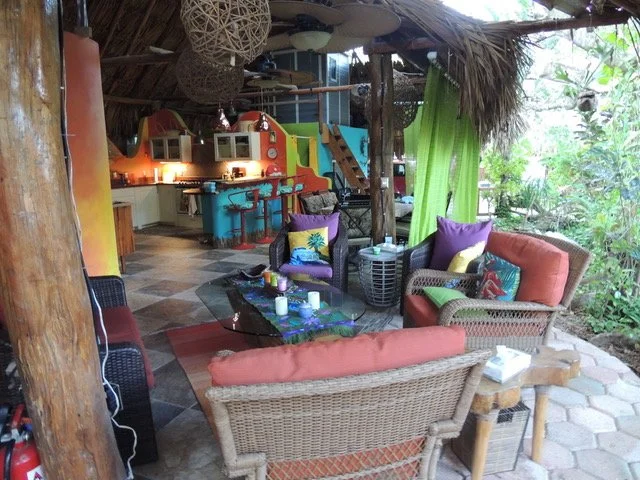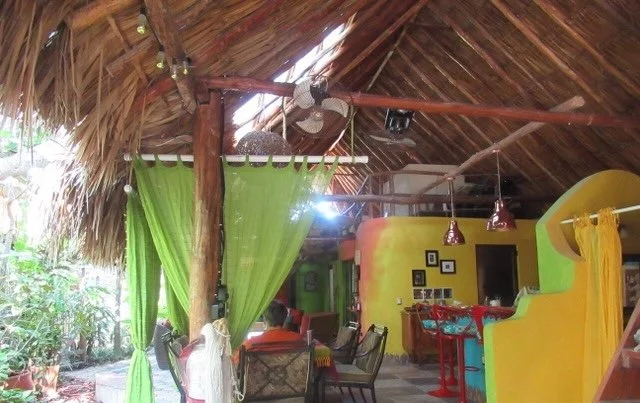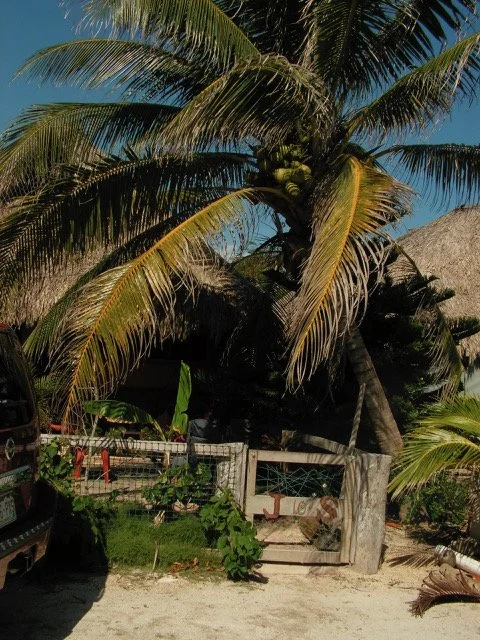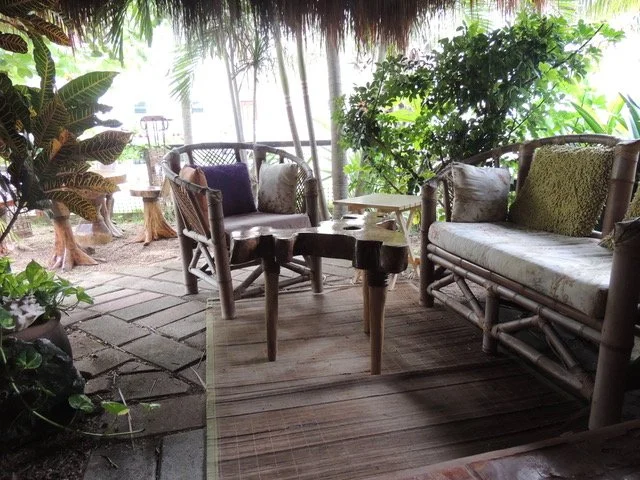What Life is Like Living in the Tropics in a Palapa
Our outdoor living room in our palapa — Photo by J. Sharland Day
Traveling with our RV in 2004, we found PaaMul, which was an RV park in the state of Quintana Roo, Mexico. It was located south of Playa del Carmen, a small beach town that catered to tourists on the Caribbean coast of the Yucatan Peninsula. We were looking for a place to camp that would have access to a dive shop, and PaaMul fit those needs.
Our plans were to stay a week and move on, but my husband, Marty, got involved with diving in the mornings and playing volleyball each afternoon. He soon fell in love with the place because he got to know so many people. But I wasn’t as enamored. I was a diver but didn’t play volleyball because of a knee injury, and I knew no one.
Being on the Caribbean coast with the azure sea close to our front door was mesmerizing to Marty, being a water sign. I am an air sign, so it wasn’t so much for me. Just give me fresh air in a beautiful setting and I’m happy; hence the wonderful aspect of palapa living, I discovered.
__________________________
PaaMul became an RV park in the 70s when the owner of the property realized it was a good place for people to stop for a respite while traveling in their RVs, since there was no other place for RVers to stay along the coast at that time. As his business grew, he added more spaces under the coconut trees. Electric and water hook-ups were installed, a restaurant/bar was built, and then a dive shop.
Many people who found the magical place wanted to stay for the winter seasons or the whole year. They wanted to be able to stay along the beautiful Caribbean Sea and were happy to pay the fair price that allowed them to do so. It was considered ‘a poor man’s paradise’ by those who stayed, and it wasn’t long before those long-termers wanted to shelter their outdoor space by building a lean-to over their areas. That was the beginning of a new look, with others doing the same, until someone else got more creative.
A wooden floor was added, and then the lean-to roof was expanded to a pole-barn concept, with poles holding up pitched roofs of palm fronds or grasses that made a much larger protected area. A palapa.
Beneath the expanded roof, folks added tables to hold a camp stove for cooking outdoors, then some decided a refrigerator would be nice. Others went a bit further and put in a makeshift bathroom, sectioned off with privacy curtains, and an outdoor shower, which was especially handy for divers who needed to wash off the saltwater after a dive.
A living room with camp chairs was sectioned off from a dining area of plastic tables and seats and ‘voila’ outdoor living was established.
Our outdoor dining room and kitchen to the right — Photo by J. Sharland Day
Other RVers came to stay and followed suit by building a palapa over their own RVs. They were happy to pay the low monthly or yearly rent for the privilege of being near the sea. It was a small community and everyone became good friends. When those friends stopped by other palapas to chat, happy hours were scheduled and invitations were spread to others in the park. A party ensued.
Over time, conveniences under the palapa roofs were enhanced with better furniture than camping chairs and tables, and the kitchens became more permanent spaces with cabinets and appliances, as were the bathrooms, which were built with privacy walls.
The outdoor living spaces soon became more elaborate. Personalities were infused in the decor to show off their creations to walkers-by. The community was born, complete with space numbers, and areas identified by location: South Side, North End, or The Barrios in the middle. Everyone knew everyone else, because most people were friendly, stopping to chat and often invited to come in and have a drink because of the openness of a palapa.
“Hi!” or “Hello! with a wave was part of one’s daily routine for most of the residents. Some imparted the proverbial gossip that went along with a small community, which was made easy while standing in front of someone’s open-air structure for a conversation.
A small flag was often posted in front of someone’s palapa to announce ‘happy hour time’ for anyone who wanted to join in. And because happy hours were frequent, many folks had hors d’oeuvres pre-made in their freezers for a quick thaw and heat to take at a moment’s notice. It was a fun time; one we looked forward to year after year, after we established ourselves in our own palapa. We’d never had so many friends in one place, nor so many activities to attend. There were volleyball games each day, diving, group card games every week, dinners once a week or more at different friend’s palapas, plus dances or karaoke at the restaurant on Fridays.
What fun to be able to greet so many friends while there. Friends who shared the same adventurous spirit.
When we would leave for the summer months to head north, we had a reliable person house-sit and take care of our palapa while we were gone. A win-win situation for us to know our palapa was secure, as well as for the person who needed a home for a few months.
Those were magical years.
The front gate to our palapa — Photo by J. Sharland Day
However, things began to change in recent years. The rent grew as the park grew, which was exponentially. There were new sections to accommodate the people who wanted a piece of paradise called: Jungle Row, The Projects, or “Hollywood.’ No one other than family members was allowed to stay in a person’s palapa or house without the owner there, unless they were taking care of a pet. The new people who came started building cinderblock houses with huge windows, rather than the palapa-style that we all fell in love with.
There were fewer “Hi’s” and “Hello’s” being hollered when people passed because the new people in the new structures didn’t know who we were, and we couldn’t see them in their closed-in spaces to get to know them. There was no more karaoke with the dances, and when we went to the restaurant, everyone looked at everyone else and wondered who the new people were.
__________________________
Now, I wonder if those of us living in palapas are seen as lower class to some of those who live in the bigger, more structured houses. And I wonder if those people who live in the multi-level houses see themselves as the upper class because it seems that our community has been divided into a class system. And that is disturbing. We all used to be of like minds: fun and adventurous. Which was the reason for finding such an inexpensive treasured place. Now, the more affluent are taking over.
I wonder if those ‘newbies’ feel superior because they are living in more solid structures that are safer from hurricanes and fires than our lowly palapas. Palapas are more vulnerable to fire, for sure, but a few years ago, one of the structured houses was destroyed by fire. We have yet to see what would happen to them in a hurricane, though, since we’ve had none in recent years, thank goodness. But I remember, during our travels one year on the west coast of Mexico, shortly after a hurricane had gone through, we saw a lot of destruction of trees as well as collapsed cinderblock buildings. Whereas the lowly palapas we could see were left standing and had only a few small holes in their roofs to be easily repaired.
Palapas, we’d been told by local Mayan workers, are built to withstand strong winds with their palm fronds or grasses for roofs tied in layers, which lets wind lift and blow through the layers instead of blowing them off.
Those newly constructed, cinderblock homes are attractive, for sure, but I still would prefer dusting a little more frequently or sweeping up some leaves blown in rather than having to drag mammoth ladders around each day for a clearer view. The huge windows need to be cleaned of the salt that the sea winds blow that cake onto the glass and make the view cloudy. And with the sand and the wind or even mere breezes, the houses are not impervious to dust.
In a palapa, one can always see clearly, even when the rains pour from the sky, unlike the windows on the houses when one is unable to see through the waterfalls that are produced by a storm. To sit and look out at nature in the mornings or evenings with the fresh air surrounding us and the sounds of birds chirping, is a wonder. A beautiful environment that the new people in cinderblock houses can’t experience while inside. To me, sitting in my outdoor living room is much better than sitting in the stale air within enclosed walls that echo, even if it is beautiful and the windows could be opened.
Another photo of our outdoor living room in our palapa — Photo by J. Sharland Day
“Hi, neighbor!” I’m always happy to impart, which I’m doing much less frequently now because I don’t know as many people, and the new ones don’t know the tradition. I can introduce myself, and I do, but when I don’t see the person again, except occasionally when we are at the same place at the same time, there are no constant reminders of who people are when I pass by solid walls and I’m unable to see who lives inside.
More and more of those cinderblock buildings are being built to take the places of the lowly palapas that are coveted by more adventurous people. And with those changes, the community is soon to lose its uniqueness of being a warm and friendly place to live and to become another cold, austere beach resort for the rich and famous. That makes me sad.



